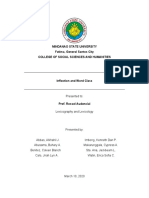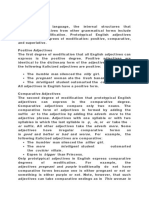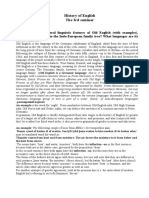Inflectional vs. Derivational Morphemes
Inflectional vs. Derivational Morphemes
Uploaded by
Santi Nugraha SariCopyright:
Available Formats
Inflectional vs. Derivational Morphemes
Inflectional vs. Derivational Morphemes
Uploaded by
Santi Nugraha SariOriginal Description:
Original Title
Copyright
Available Formats
Share this document
Did you find this document useful?
Is this content inappropriate?
Copyright:
Available Formats
Inflectional vs. Derivational Morphemes
Inflectional vs. Derivational Morphemes
Uploaded by
Santi Nugraha SariCopyright:
Available Formats
Inflectional vs.
Derivational Morphemes Handout
Ling 201
Inflectional
⋅ An inflectional morpheme is added to a noun, verb, adjective or adverb to assign a
particular grammatical property to that word such as: tense, number, possession, or
comparison.
⋅ Examples of inflectional morphemes are:
o Plural: -s, -z, -iz
Like in: cats, horses, dogs
o Tense: -d, -t, -id, -ing
Like in: stopped, running, stirred, waited
o Possession: -‘s
Like in: Alex’s
o Comparison: -er, -en
Like in: greater, heighten
*note that –er is also a derivational morpheme so don’t mix them up!!
⋅ These do do not change the essential meaning or the grammatical category of a word.
Adjectives stay adjectives, nouns remain nouns, and verbs stay verbs.
⋅ In English, all inflectional morphemes are suffixes (i.e. they all only attach to the end of
words).
⋅ There can only be one inflectional morpheme per word
Derivational
⋅ Derivational morphemes tend to change the grammatical category of a word but not
always!
⋅ There can be multiple derivational morphemes per word and they can be prefixes, affixes,
or suffixes. For example, the word “transformation” contains two derivational
morphemes: trans (prefix) -form (root) -ation (suffix)
⋅ Some examples of derivational morphemes are:
o -ful like in ‘beautiful’ => beauty (N) + ful (A) = beautiful (A)
o -able like in ‘moldable’ => mold (V) + able (A) = moldable (A)
o -er like in ‘singer’ => sing (V) + er (N) = singer (N)
o -nes like in ‘happiness’ => happy (A) + nes (N) = happiness (N)
o -ify like in ‘classify’ => class (N) + ify (V) = classify (V)
Determining Derivational vs. Inflectional Morphemes
Derivational
⋅ If it changes the part of speech, it must be derivational.
⋅ If it is at the beginning of a word, it must be derivational
Inflectional vs. Derivational Morphemes Handout
Ling 201
⋅ If it is followed by one of the inflectional morphemes listed above, it must be
derivational.
⋅ If there is an inflectional morpheme, then every other morpheme must be derivational
(since only one inflectional morpheme is allowed per word).
Inflectional
⋅ If it adds a particular grammatical property like tense, number, possession, or
comparison, it must be inflectional
⋅ This is related to productivity: if it is adding a grammatical property, it is productive.
You might also like
- SpeechLanguage Development ChartDocument10 pagesSpeechLanguage Development ChartFelipe Apablaza Campos100% (2)
- Do You Want To Speak CzechDocument99 pagesDo You Want To Speak CzechJuan100% (1)
- Biblical HebrewDocument244 pagesBiblical HebrewWitan00100% (26)
- Lecture 2Document8 pagesLecture 2Катeрина КотовичNo ratings yet
- McWhorter (2002) What Happended To EnglishDocument56 pagesMcWhorter (2002) What Happended To EnglishCarla MaggioreNo ratings yet
- 2013 Journal - Hickey and Lewis - Morphology 101Document16 pages2013 Journal - Hickey and Lewis - Morphology 101api-251212504No ratings yet
- MorphologyDocument89 pagesMorphologyMarc Jasson CalaylayNo ratings yet
- Word FormationDocument17 pagesWord FormationNika LavidiaNo ratings yet
- 4 Words and MorphologyDocument2 pages4 Words and MorphologygsjgalghjerslhdrgawgNo ratings yet
- MorphologyDocument7 pagesMorphologyputri nur rahmadhaniNo ratings yet
- MorphologyDocument33 pagesMorphologydevans2020narayananNo ratings yet
- Bound Morpheme 2Document15 pagesBound Morpheme 2fatimaasghar837No ratings yet
- MORPHOLOGY-1Document20 pagesMORPHOLOGY-1kay93340No ratings yet
- Word Formation and Structure: Derivational PatternsDocument10 pagesWord Formation and Structure: Derivational PatternsKaosar ZamanNo ratings yet
- Derivational & Inflectional MorphologyDocument14 pagesDerivational & Inflectional MorphologyMishell CamachoNo ratings yet
- Derivation and Inflection MorphemeDocument11 pagesDerivation and Inflection MorphemeGilbert MalauNo ratings yet
- Colorful Playful Creative Portfolio Presentation 1Document67 pagesColorful Playful Creative Portfolio Presentation 1ducosamchristianNo ratings yet
- Affix NoraDocument7 pagesAffix NoraPutra AtjehNo ratings yet
- Morphology LinguisticsDocument20 pagesMorphology LinguisticsNurul KhotimahNo ratings yet
- Derivation Vs InflectionDocument2 pagesDerivation Vs InflectionCaesar Zeal El-khatrNo ratings yet
- BA 6th Sem INFLECTION AND DERIVATION NOTE PDFDocument2 pagesBA 6th Sem INFLECTION AND DERIVATION NOTE PDFRo Lu100% (2)
- Definitions and ExercisesDocument12 pagesDefinitions and ExercisesYara AhmedNo ratings yet
- Zabdiel PluralsDocument7 pagesZabdiel PluralsIsmerai NuñezNo ratings yet
- Present Perfect InglesDocument20 pagesPresent Perfect InglespapaiguezNo ratings yet
- VerbsDocument38 pagesVerbsEdher Quintanar0% (2)
- Unit 1 (Cont.) MorphemesDocument20 pagesUnit 1 (Cont.) Morphemestrang nguyễn thị hươngNo ratings yet
- Spelling RulesDocument5 pagesSpelling RulesPriyanka 283No ratings yet
- Ch. 1-4 Grammar HandoutDocument2 pagesCh. 1-4 Grammar HandoutMatthew JohnsonNo ratings yet
- Buổi 3 - Chap 3 - A word and its parts_ roots, affixes and their shapesDocument8 pagesBuổi 3 - Chap 3 - A word and its parts_ roots, affixes and their shapesNguyễn Khánh DungNo ratings yet
- 4299036Document24 pages4299036Nahla's Online CoursesNo ratings yet
- Structural Analysis of WordsDocument17 pagesStructural Analysis of WordsFernanda FloresNo ratings yet
- Morpheme & MorphologyDocument14 pagesMorpheme & MorphologyAida NurinNo ratings yet
- Inflection Word Class - Written ReportDocument17 pagesInflection Word Class - Written ReportJochebeb ToledoNo ratings yet
- Morphology WrittenDocument3 pagesMorphology WrittenReinabelle RasonableNo ratings yet
- AdjDocument16 pagesAdjnkenzhebekyzyNo ratings yet
- 1Document2 pages1ALEXANDRU-GABRIEL ROINIȚĂNo ratings yet
- Morphological Derivation - WikipediaDocument14 pagesMorphological Derivation - WikipediaBo SanNo ratings yet
- Preamble (Past Lesson Brief) : Meaning or Grammatical Function Within A Language. The Two Main Categories, Free and BoundDocument12 pagesPreamble (Past Lesson Brief) : Meaning or Grammatical Function Within A Language. The Two Main Categories, Free and BoundNaureen MumtazNo ratings yet
- Unit 4 MorphologyDocument45 pagesUnit 4 MorphologyNapatNo ratings yet
- Inflectional MorphemesDocument7 pagesInflectional Morphemesapi-296553705100% (6)
- Ejonekto - The Language of The OccultDocument23 pagesEjonekto - The Language of The OccultSᴡᴇᴇᴛ LᴇᴍᴏɴᴀᴅᴇNo ratings yet
- MorphologyDocument54 pagesMorphologyVinay PanditNo ratings yet
- Parallel StructuresDocument12 pagesParallel StructuresMariel SarabiaNo ratings yet
- MORPHOLOGY (Morphs, Allomorph, Grammatical and Phonological Conditioning)Document17 pagesMORPHOLOGY (Morphs, Allomorph, Grammatical and Phonological Conditioning)Sergio Felix CuratacaniNo ratings yet
- MorphologyDocument39 pagesMorphologyThảo NguyênNo ratings yet
- Humble Silly Pregnant Fresh Intelligent CockyDocument5 pagesHumble Silly Pregnant Fresh Intelligent CockyRKT SOLUTION TP Help DeskNo ratings yet
- Resumen GrammarDocument16 pagesResumen GrammarChiara CutroneNo ratings yet
- 1ro BguDocument17 pages1ro Bgualejandrogranda941No ratings yet
- Plurals of Nouns - LectureDocument3 pagesPlurals of Nouns - Lecturealvarez9654No ratings yet
- 2.2_Morphology_W3Document20 pages2.2_Morphology_W3aizadfikri24No ratings yet
- ALLOMORPHSDocument10 pagesALLOMORPHScieda_89No ratings yet
- Module 4Document31 pagesModule 4Ams SagittariusNo ratings yet
- Phrases: Andi Darmawan 4114110020Document22 pagesPhrases: Andi Darmawan 4114110020Zulfida Fahmi AnggrainiNo ratings yet
- MorphologyDocument89 pagesMorphologyaaron johnNo ratings yet
- SOL-week 3Document31 pagesSOL-week 3kn9zrmpn82No ratings yet
- Inflectional and DerivationalDocument41 pagesInflectional and Derivationalummi zulaikha bt mohd nor100% (2)
- Verbs: Passive Voice ParticiplesDocument8 pagesVerbs: Passive Voice ParticiplesJelena PopovicNo ratings yet
- English Language StudiesDocument236 pagesEnglish Language Studiesprogideon1No ratings yet
- ParticipleDocument19 pagesParticipleMaria Krystina Cassandra YañezNo ratings yet
- Overview of English MorphologyDocument9 pagesOverview of English MorphologyRed RoseNo ratings yet
- Morpheme SDocument3 pagesMorpheme SvalentinaivanovskaNo ratings yet
- Linguistics Morphology 1Document35 pagesLinguistics Morphology 1Armina QuirongNo ratings yet
- A Comparative Study Guide Spanish to English to ItalianFrom EverandA Comparative Study Guide Spanish to English to ItalianRating: 3 out of 5 stars3/5 (2)
- English NotesDocument3 pagesEnglish NotesHadaza LanaNo ratings yet
- History of English 3Document9 pagesHistory of English 3VLAD DRAKULANo ratings yet
- Wayana, A Grammar of (Da Silva)Document454 pagesWayana, A Grammar of (Da Silva)Rydzek MapperNo ratings yet
- Lecture 1 LexicologyDocument6 pagesLecture 1 LexicologyAlexa NicolNo ratings yet
- Stand Alone RomanianDocument197 pagesStand Alone Romanianlemmy90No ratings yet
- Answer ELS Answer in Unit 2 (Written Activity)Document14 pagesAnswer ELS Answer in Unit 2 (Written Activity)Ana Amistad100% (3)
- Ajit Vadakayil - Sanskrit The Digital Language Versus English - Capt Ajit VadakayilDocument25 pagesAjit Vadakayil - Sanskrit The Digital Language Versus English - Capt Ajit VadakayilethicalsociopathNo ratings yet
- MorphologyDocument6 pagesMorphologyazicajurao16No ratings yet
- Methodical Bible Study: A New Approach To HermeneuticsDocument26 pagesMethodical Bible Study: A New Approach To HermeneuticsSem JeanNo ratings yet
- Booij Inflection and Derivation PDFDocument8 pagesBooij Inflection and Derivation PDFtruongkhoilenguyenNo ratings yet
- Catalogo 2013Document64 pagesCatalogo 2013RaquelJacobNo ratings yet
- Activity 3-Structure of EnglishDocument2 pagesActivity 3-Structure of EnglishAnskee Tejam100% (1)
- A Pedagogic Grammar For Cebuano Visayan LectureDocument9 pagesA Pedagogic Grammar For Cebuano Visayan LectureJemelyn VergaraNo ratings yet
- Intro 6 MorphologyDocument27 pagesIntro 6 MorphologyLaura BodaNo ratings yet
- FluentU The Complete Guide To Instant English ImmersionDocument10 pagesFluentU The Complete Guide To Instant English ImmersionRichard PriorNo ratings yet
- Interference in Learning English: Grammatical Errors in English Essay Writing Among Rural Malay Secondary School Students in MalaysiaDocument15 pagesInterference in Learning English: Grammatical Errors in English Essay Writing Among Rural Malay Secondary School Students in Malaysiashahrole fahmieNo ratings yet
- Chapter2 MorphologyDocument4 pagesChapter2 MorphologyBearish PaleroNo ratings yet
- Inflectional and DerivationalDocument7 pagesInflectional and DerivationalMarilyn ZhindonNo ratings yet
- GrammarDocument8 pagesGrammarfemywinataNo ratings yet
- Анотації лекцій - Лексикологія англ мовиDocument24 pagesАнотації лекцій - Лексикологія англ мовиsemenal2907No ratings yet
- Design and Development of Morphological Analyzer For Tigrigna Verbs Using Hybrid ApproachDocument12 pagesDesign and Development of Morphological Analyzer For Tigrigna Verbs Using Hybrid ApproachDarrenNo ratings yet
- Download Bosnian Croatian Serbian a Textbook With Exercises and Basic Grammar 2nd Edition Ronelle Alexander ebook All Chapters PDFDocument85 pagesDownload Bosnian Croatian Serbian a Textbook With Exercises and Basic Grammar 2nd Edition Ronelle Alexander ebook All Chapters PDFmughilobese1100% (5)
- Chapter IVDocument17 pagesChapter IVHoang Thi Hai YenNo ratings yet
- Contrastive GrrammarDocument152 pagesContrastive GrrammarKendra WalkerNo ratings yet
- 4A06 Dinh Ly Van Khanh A Contrastive Analysis of English and Vietnamese MorphemesDocument14 pages4A06 Dinh Ly Van Khanh A Contrastive Analysis of English and Vietnamese MorphemesLe HuonglanNo ratings yet

























































































